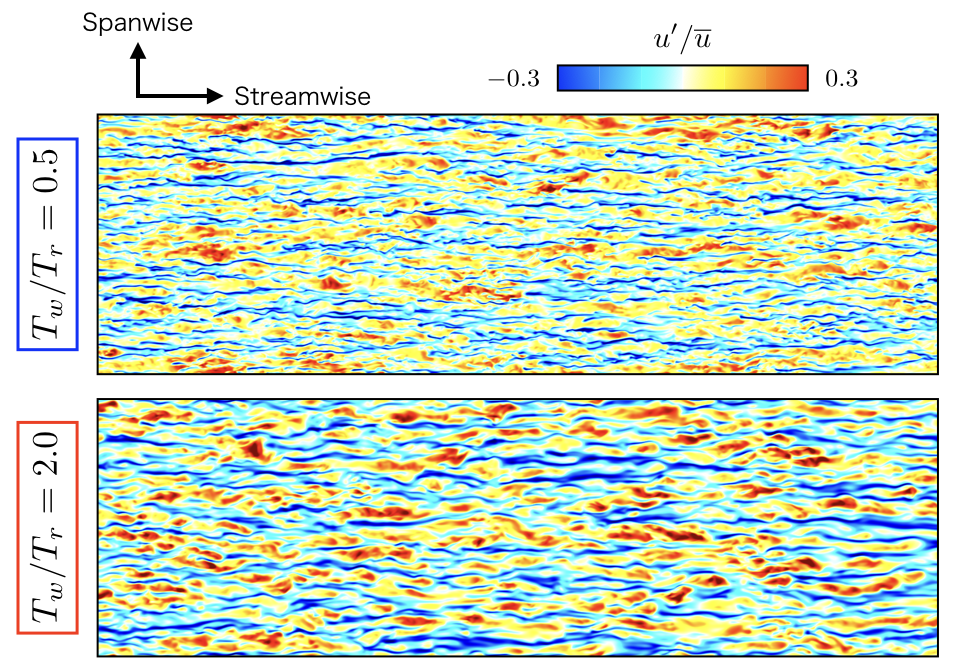Physics and modeling of compressible thermal turbulent boundary layers
JAXA Supercomputer System Annual Report April 2018-March 2019
Report Number: R18EACA31
Subject Category: JSS2 Inter-University Research
- Responsible Representative: Soshi Kawai, Associate Professor, Tohoku University
- Contact Information: Ryo Hirai(hirai@cfd.mech.tohoku.ac.jp)
- Members: Soshi Kawai, Kosuke Totani
Abstract
In this study, we first analyze compressible thermal turbulent boundary layers on a flat plate including the heat flux such as cooling/heating from the wall surface using LES, and then we aim to construct reliable wall modeling in LES which can evaluate the effects of wall heat flux by understanding the physical phenomena of heated/cooled turbulent boundary layers.
Reference URL
Please refer to ‘Kawai Lab. – Aerospace Dept., Tohoku University‘.
Reasons for using JSS2
High fidelity LES computations of compressible turbulent boundary layers require significant computational costs. Therefore, a large scale parallel computation using a supercomputer is mandatory.
Achievements of the Year
In this study, we compute turbulent boundary layers with wall heat flux by using wall-resolved LES to understand the physical phenomena of the turbulent boundary layers with heated/cooled walls and also to develop a wall-modeling in LE based on the elucidated flow physics. In this year, the thermal turbulent boundary layers with various wall temperature conditions are computed, and we analyzed the turbulence statistics and structures. The Reynolds number and Mach number of incoming flow are set as Re = 2,500 and M = 2.28, respectively (the length of Reynolds number is based on the momentum thickness of the boundary layer). As the spatial discretization method, the sixth-order compact difference scheme is used. The time integration method is the third-order TVD Runge-Kutta method. In this study, we consider five different heated/cooled wall temperature conditions, Tw / Tr = 0.5, 0.75, 1.0, 1.5, 2.0 (where Tr is recovery temperature). The cooled wall conditions are the cases of Tw / Tr < 1.0, the heated wall conditions are the case of Tw / Tr > 1.0, and the quasi-adiabatic wall condition is the case of Tw / Tr = 1.0.
The van Driest transformed mean velocity profiles (Fig. 1) indicates that the result of quasi-adiabatic wall condition (Tw / Tr = 1.0) agrees well with the result of DNS. On the other hand, the log-layer obtained by the heated and cooled wall conditions show a shift in the additive constant of the logarithmic law. The heated and cooled cases show an lower and upper shift to the log-law, respectively. In addition, the degree of the mismatch increases when the strength of heating and cooling is increased. This suggests that a certain physical law of the turbulent statistics in the inner layer of the boundary layer with heat flux exists. Instantaneous flowfield of the streamwise velocity fluctuations at y+ = 20 in the cases of Tw / Tr = 0.5, 2.0 are shown in Fig. 2. Smaller streak structures are observed in the case of cooled wall condition (Tw / Tr = 0.5), whereas the turbulent structures become larger in the case of heated wall condition (Tw / Tr = 2.0). These turbulent structures are important for generating and maintaining the turbulent flows, and thus we conlude that the flow physics in the inner layer of turbulent boundary layers are largely influenced by the wall heat flux.

Fig.1: Van Driest transformed mean streamwise-velocity with heated and cooled wall-temperature conditions.
Publications
– Oral Presentations
(1) K. Totani, Y, Kuya, S. Kawai, “High-order-accurate physically-consistent kinetic energy conservation scheme on curvilinear grids,” 50th Fluid Dynamics Conference/36th Aerospace Numerical Simulation Symposium, Miyazaki, Japan, July, 2018.
(2) K. Totani, Y, Kuya, S. Kawai, “High-order-accurate kinetic energy and entropy preserving schemes on curvilinear meshes,” SciTech2019, San Diego, California, AIAA-2019-1403, January 2019.
– Poster Presentations
(1) R. Hirai, S. Kawai, “LES analysis of turbulent boundary layer with wall heat flux for wall modeling in LES”, 2nd Aircraft Aerodynamics Research Workshop, Miyagi, March 2019.
Usage of JSS2
Computational Information
- Process Parallelization Methods: MPI
- Thread Parallelization Methods: OpenMP
- Number of Processes: 128 – 285
- Elapsed Time per Case: 140 Hour(s)
Resources Used
Fraction of Usage in Total Resources*1(%): 0.01
Details
Please refer to System Configuration of JSS2 for the system configuration and major specifications of JSS2.
| System Name | Amount of Core Time(core x hours) | Fraction of Usage*2(%) |
|---|---|---|
| SORA-MA | 85,777.07 | 0.01 |
| SORA-PP | 0.00 | 0.00 |
| SORA-LM | 0.00 | 0.00 |
| SORA-TPP | 0.00 | 0.00 |
| File System Name | Storage Assigned(GiB) | Fraction of Usage*2(%) |
|---|---|---|
| /home | 105.86 | 0.11 |
| /data | 2,012.25 | 0.04 |
| /ltmp | 4,101.56 | 0.35 |
| Archiver Name | Storage Used(TiB) | Fraction of Usage*2(%) |
|---|---|---|
| J-SPACE | 0.00 | 0.00 |
*1: Fraction of Usage in Total Resources: Weighted average of three resource types (Computing, File System, and Archiver).
*2: Fraction of Usage:Percentage of usage relative to each resource used in one year.
JAXA Supercomputer System Annual Report April 2018-March 2019



